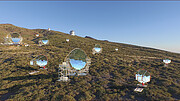Announcement
The CTAO will double its staff as major infrastructure development begins in 2024
25 September 2023
Progress in the Cherenkov Telescope Array Observatory (CTAO) –– the world’s most powerful ground-based gamma-ray observatory –– will be bolstered by a recent funding pledge from its governing bodies. On 6 September 2023, the CTAO’s Board of Governmental Representatives and the CTAO gGmbH Council, of which ESO is a member, met to agree on the next steps to advance the CTAO to its construction phase. As part of their unanimous commitment to the progress of the project, all members agreed on a foreseen endorsement of up to approximately 30 million euro for 2024. This significant increase in the CTAO’s funding will allow it to build new infrastructure and double the workforce.
The CTAO will consist of two arrays of telescopes: CTAO-North in La Palma, Spain, and CTAO-South at ESO’s Paranal Observatory in Chile. After extensive design and pre-construction activities, such as testing a prototype telescope in the northern site, the new funding pledge will allow the CTAO to proceed forward on various fronts. In particular, in 2024 the CTAO plans to open at least 30 new positions, and start major infrastructure development in its southern site such as building roads, power systems, and foundations. “We welcome the steadfast commitment of all members to the progress of the CTAO, and we look forward to hosting the southern array at our Paranal site,” said Xavier Barcons, ESO Director General.
The CTAO currently operates as a gGmbH –– a non-profit limited-liability entity under German law –– and is now in the process of becoming a European Research Infrastructure Consortium (ERIC), which will function under European law. The first step of this process has been completed, and discussions with the European Commission about the second step are still ongoing. This new agreement between the governing bodies of the CTAO will allow the project to keep moving forward in the meantime.
In its planned configuration, the CTAO will comprise 64 telescopes of different sizes, 13 in the northern site and 51 in the southern one. These telescopes will detect the faint and ephemeral radiation produced when high-energy particles from deep space hit our atmosphere, thus probing the most powerful and extreme events in the Universe with unprecedented sensitivity. CTAO’s high-energy capabilities constitute a perfect match to ESO’s current roster of telescopes, which observe all the way from visible/infrared light to submillimetre wavelengths, a synergy that will allow astronomers to study the Universe in brand new ways.
Links
Contacts
Juan Carlos Muñoz Mateos
ESO Media Officer
Garching bei München, Germany
Tel: +49 89 3200 6176
Email: press@eso.org
About the Announcement
| Id: | ann23014 |
Our use of Cookies
We use cookies that are essential for accessing our websites and using our services. We also use cookies to analyse, measure and improve our websites’ performance, to enable content sharing via social media and to display media content hosted on third-party platforms.
ESO Cookies Policy
The European Organisation for Astronomical Research in the Southern Hemisphere (ESO) is the pre-eminent intergovernmental science and technology organisation in astronomy. It carries out an ambitious programme focused on the design, construction and operation of powerful ground-based observing facilities for astronomy.
This Cookies Policy is intended to provide clarity by outlining the cookies used on the ESO public websites, their functions, the options you have for controlling them, and the ways you can contact us for additional details.
What are cookies?
Cookies are small pieces of data stored on your device by websites you visit. They serve various purposes, such as remembering login credentials and preferences and enhance your browsing experience.
Categories of cookies we use
Essential cookies (always active): These cookies are strictly necessary for the proper functioning of our website. Without these cookies, the website cannot operate correctly, and certain services, such as logging in or accessing secure areas, may not be available; because they are essential for the website’s operation, they cannot be disabled.
Functional Cookies: These cookies enhance your browsing experience by enabling additional features and personalization, such as remembering your preferences and settings. While not strictly necessary for the website to function, they improve usability and convenience; these cookies are only placed if you provide your consent.
Analytics cookies: These cookies collect information about how visitors interact with our website, such as which pages are visited most often and how users navigate the site. This data helps us improve website performance, optimize content, and enhance the user experience; these cookies are only placed if you provide your consent. We use the following analytics cookies.
Matomo Cookies:
This website uses Matomo (formerly Piwik), an open source software which enables the statistical analysis of website visits. Matomo uses cookies (text files) which are saved on your computer and which allow us to analyze how you use our website. The website user information generated by the cookies will only be saved on the servers of our IT Department. We use this information to analyze www.eso.org visits and to prepare reports on website activities. These data will not be disclosed to third parties.
On behalf of ESO, Matomo will use this information for the purpose of evaluating your use of the website, compiling reports on website activity and providing other services relating to website activity and internet usage.
Matomo cookies settings:
Additional Third-party cookies on ESO websites: some of our pages display content from external providers, e.g. YouTube.
Such third-party services are outside of ESO control and may, at any time, change their terms of service, use of cookies, etc.
YouTube: Some videos on the ESO website are embedded from ESO’s official YouTube channel. We have enabled YouTube’s privacy-enhanced mode, meaning that no cookies are set unless the user actively clicks on the video to play it. Additionally, in this mode, YouTube does not store any personally identifiable cookie data for embedded video playbacks. For more details, please refer to YouTube’s embedding videos information page.
Cookies can also be classified based on the following elements.
Regarding the domain, there are:
- First-party cookies, set by the website you are currently visiting. They are stored by the same domain that you are browsing and are used to enhance your experience on that site;
- Third-party cookies, set by a domain other than the one you are currently visiting.
As for their duration, cookies can be:
- Browser-session cookies, which are deleted when the user closes the browser;
- Stored cookies, which stay on the user's device for a predetermined period of time.
How to manage cookies
Cookie settings: You can modify your cookie choices for the ESO webpages at any time by clicking on the link Cookie settings at the bottom of any page.
In your browser: If you wish to delete cookies or instruct your browser to delete or block cookies by default, please visit the help pages of your browser:
Please be aware that if you delete or decline cookies, certain functionalities of our website may be not be available and your browsing experience may be affected.
You can set most browsers to prevent any cookies being placed on your device, but you may then have to manually adjust some preferences every time you visit a site/page. And some services and functionalities may not work properly at all (e.g. profile logging-in, shop check out).
Updates to the ESO Cookies Policy
The ESO Cookies Policy may be subject to future updates, which will be made available on this page.
Additional information
For any queries related to cookies, please contact: pdprATesoDOTorg.
As ESO public webpages are managed by our Department of Communication, your questions will be dealt with the support of the said Department.


